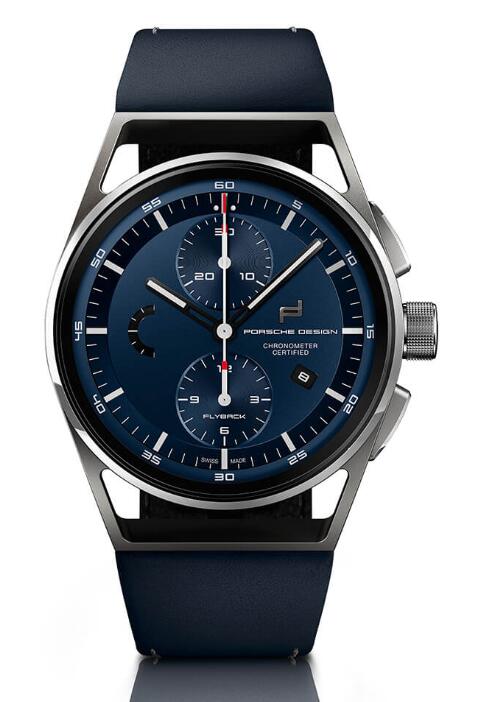Porsche Design releases dark blue version of 1919 Chronotimer Flyback watch
Porsche Design (Porsche Design) launched the latest version of its 1919 Chronotimer Flyback watch, introducing dark blue to the luxury collection. Following the brown color scheme released two years ago, the latest version retains the brand’s latest technical details and sports style.
In 1919, Chronotimer Flyback was made of 100% titanium and had a lightweight feel. In order to add more to this German car manufacturer’s iconic brand clues, the strap is made of genuine Porsche leather and decorated with grey stitching to create a sharp contrast. Other details include the flyback function with observatory certified accuracy, Porsche Design’s Werk 01.200 movement and sapphire crystal glass case, sandblasted surface. The logo on the front and back of the watch perfectly presents it.
Porsche Design 1919 Chronotimer Flyback brown and leather
In 2018, Porsche Design launched a minimalist chronograph whose color is driven by its proprietary flyback movement and has unusual colors.
My interest in Porsche Design was caused by Porsche Design at IWC Ocean 2000. That model also became a watch that aroused my deeper interest in mechanical watches. It took a while until that watch entered my collection. But this is another story. Let us study Chronotimer Flyback Brown & Leather in 1919.
A little history
Orfina produced the first watch with the Porsche design name in 1972. This is Chronograph1. The outstanding feature of this watch is its color-the entire surface is matte black. The case, bracelet and dial all show this color, which was very unusual at the time.
In 1977, the famous cooperation with IWC began. Except for Ocean 2000, the most famous watch of that era may be the Titanium Chronograph. The name has indicated the main feature of the Wholesale watch produced by this collaboration: titanium as the material for the case and bracelet. The connection with IWC ended in 1995.
In the same year, Porsche Design acquired Eterna, which has since produced Porsche Design watches. Although Porsche has designed impressive (and expensive) indicators, mechanical chronographs with digital displays (replacement of hands with numbers) (the brand was launched in 2004), Porsche-designed watches are rarely released . In 2007, this collaboration resulted in Worldtimer, a revolutionary practical concept that can handle different time zones. The case of this watch is very similar to the case of the subject of this article-1919 Chronograph series. Since 2010, Eterna has redesigned the famous early Porsche design watch. In 2011, Porsche Design sold Eterna to China Haidian Group (now known as Citychamp Watch and Jewelry Group, which is also the owner of Corum), and ceased production of Porsche Design watches.
In 2014, Porsche Design finally established Porsche Design Timepieces, a company headquartered in Solothurn, Switzerland, and completely handed over the production of watches to its own hands.
1919 Chronotimer Flyback Brown
When you watch the 1919 Chronotimer Flyback Brown, you will find the most distinctive feature is the color of the dial. Dark chocolate brown is a hue you rarely encounter on watches, especially sports chronographs. For Porsche Design, a brand known for its color scheme with black and titanium as the main color, using brown is almost a violation of convention. However, just like the popular blue dial, the brown dial produces less contrast than black or white.
1919 Chronotimer’s second outstanding feature is the lugs. As protruding hollow mounting brackets, they visually separate the strap from the case. This produces a technical, futuristic and lightweight impression-a clear visual appearance. The gap between the case and the strap allows you to glance at your wrist, but I did not notice that it will distract you.
The next visual effect that attracts your attention is the bright white index finger and pointer. The hour and minute hands are partially hollowed out to integrate the design of the lugs with the display. The combination of a bright index and a matte dial gives a visual impression of the instrument panel. The design of the embedded accumulator reinforces this, the accumulator indicates the number of minutes (12 o’clock) and hours (6 o’clock). When the pointer of the timer is not reset to zero, the similarity to the instrument panel will be stronger. cheap watches price
plan the details
The small second hand at nine o’clock is reduced to a running indicator. One indicator of this indicator is slightly heavier, so you can use it as a reference to set the time accurately. There is a date window at four o’clock, which hardly attracts attention. The aperture is small, there is no border, the background is the same color as the dial, and the font is the same as the rest of the dial. perfect!
The rectangular chronograph button has been perfectly integrated into the shape of the case. The fact that only one side of these pushers protrudes from the housing does not affect usability. The solid knurled screw-in crown completes the sporty look of the watch. The middle part of the case is sandblasted with glass beads, and the top and bottom are polished. Pay attention to the subtle visual effects produced by the polished edges of the timing buttons. The crystal at the bottom of the case shows the movement.
Even for me, as a German, the name of the Chronotimer Flyback Brown & Leather caliber in 1919 also appeared Teutonic. However, considering that this is the first movement in the past 50 years since Porsche Design has provided a watch, it may be an appropriate name. To be precise, it is WERK 01.200.
This movement was first proposed as the driving force in the Chronotimer 911 Turbo S Exclusive Series. This watch is specially provided for car owners with the same name. It is indeed a very unique watch. Next, WERK 01.200 appeared in the special edition of Chronotimer Flyback. In 1919, Chronotimer Flyback Brown & Leather was the third watch containing this movement.

Porsche Design is still a design studio, without watchmaking. The movement is manufactured by the Concepto watch factory in La Chaux-de-Fonds. Porsche Design (Porsche Design) is heavily involved in the design work, which is obvious. Many black surfaces are visible on the back of the chronograph’s display. They are covered with a matte black coating and are scattered with a miniature Porsche design logo.
The most prominent part of this movement is the black rotor with a pendulum made of tungsten. Tungsten is a material rarely used in watch movements. The processing of tungsten is a bit complicated, because it has the highest melting point of all chemical elements, and tungsten chips are easy to catch fire. But tungsten is very heavy (almost as heavy as gold), which is obviously the most important feature of the pendulum. In addition, it is relatively cheap.
The layout of this movement is intentionally similar to the layout of ETA 7750. In this way, if the Swatch Group eventually stops providing ETA movements outside the Swatch Group, WERK 01.200 can easily replace the 7750 in the existing watch models. When you press the timer button, you will immediately feel that it is not 7750. The function of the button is softer, similar to the timer controlled by the column wheel.
The finishing of movement parts is quite industrial. There is no traditional decoration, only simple polishing. In any case, these components are refined enough to obtain COSC certification.
Strap and clasp
In 1919, Chronotimer Flyback Brown & Leather was paired with a dark brown calfskin strap and was carefully sewn in the same color. The leather used for this strap is the same as the seat of a Porsche car. Although this may be an exciting feature for Porsche car fans, I think it is not the best solution. Leather is a bit difficult to be truly comfortable, and it does not change over time. But at least it looks good.
The strap is closed by a double folding clasp made of titanium. The matte surface of the clasp is the same as the sandblasted parts of the case. Unfortunately, the full folding clasp is quite thick. The support area of the folding mechanism inside the belt is small. When placing your wrist on the arm of a table or chair, a small part of the folding mechanism will squeeze into your wrist. After a short time, when I wore the Chronotimer in the office, it was so damaged that I had to take off my watch. I have never encountered any other watch like this.
I asked Porsche Design for the buckle of the watch. The bad news is: there is no pin buckle. The good news is that you can remove the entire folding mechanism from the folding buckle and then connect the remaining buckle directly to the belt as if there were never any folding mechanism.
So I did. However, there is a tricky little detail when disassembling the folding mechanism. The parts tied to the belt are fixed in place by two small pins. Both pins have screw grooves. Only one of these pins can be loosened. The other pin is fixed on the folding mechanism. When you try to loosen the pin firmly, the head of the pin will be damaged. I tried to unscrew the pin, but it was damaged. After that, I realized that I only need to remove one needle to remove the belt.
What really annoys me here is that the non-releasable pin hints at a non-existent function. This is the company’s design credo, “form follows function”! I want to talk to the designer who created this folding mechanism.
The belt was abnormally attached to the box. The edges of the belt are flush with the lugs, rather than between them like traditional lugs. This produces a different appearance and contributes greatly to the overall futuristic appearance of the watch. The disadvantage is that you can only use Porsche Design’s proprietary belts. The pin connecting the belt to the case is not a spring rod. These seem to be similar to the pins connecting the bracelet links. Using standard watchmaking tools, I cannot remove the strap. This means that you can not only connect the original Porsche design strap to the 1919 Chronotimer alone, but even need to be done by Porsche Design Services.
The 1919 Chronotimer Flyback Brown & Leather has a unique design. The successful fusion of futuristic, elegant and sporty elements, however, merges the cramped overall appearance. In 2019, it won the “Red Dot Design Award” “Best of the Best”.
Porsche Design’s proprietary movement is compelling. The function of the chronograph is surprisingly excellent and provides good accuracy. The strap looks good and is combined with the iconic lugs to provide a guarantee for the unique appearance of this watch. In other words, leather may be more comfortable. The solution to secure the strap to the lug may be more consumer oriented. Although folding buckles are generally considered to be more comfortable and safer than pin buckles, in this case, I still think that such buckles are not wear-resistant. Fortunately, you can convert it to a pin buckle.
